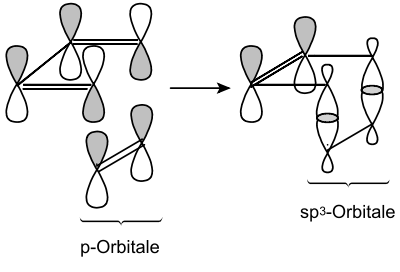Cycloaddition
Cycloaddition is a chemical reaction in organic chemistry. In general, two (or more) unsaturated systems react with each other by ring closure. Cycloadditions are usually designated by an abbreviation in front of the name, which indicates how many π 


Cycloaddition is a special case of pericyclic reactions. The best known and most common special case of cycloaddition is the [4+2]-cycloaddition, which also includes the Diels-Alder reaction. In addition, Huisgen 1,3-dipolar cycloaddition still exists, which is useful for the preparation of heterocycles. The [2+2]-cycloaddition is an example of a photochemical reaction. Here, in the case of a Paternò-Büchi reaction, an alkene and a ketone react to form an oxetane.
The course of these reactions can be both photochemical and thermal, this is generally dependent on the number of π 






In the illustrated case of the Diels-Alder thermal reaction, a suprafacial attack occurs; both bonds are formed on the same side of the molecule.
Notation
The naming of a cycloaddition reaction can be done in two different ways according to the IUPAC recommendations.
(i + j + ...)-cycloaddition
In this notation, i and j and ... contiguous atoms of the reacting species are linked to form a ring system with a total of i + j + ... atoms. Accordingly, the above Diels-Alder reaction is a (4+2)-cycloaddition. The formation of the primary product of ozonolysis is called (3+2)-cycloaddition.
[m + n + ...]-cycloaddition
In this preferred notation, m and n and ... electrons are involved in the formation of the ring system on the reacting species, respectively. Thus, both the above Diels-Alder reaction and the first step of ozonolysis are [4+2]-cycloadditions.
Cheletrope reaction
Cheletropic reactions are a special case of cycloaddition. In these reactions, the newly formed bonds start from the same atom. An example is the addition of a carbene to the double bond of an alkene. These reactions can also be reproduced using the frontier orbital method. Two σ-bonds starting from the same atom are opened or closed simultaneously.
Questions and Answers
Q: What is a cycloaddition?
A: A cycloaddition is a chemical reaction between reactants with double bonds that get replaced by a ring structure.
Q: What type of chemical reaction is a cycloaddition?
A: A cycloaddition is a pericyclic chemical reaction where "two or more unsaturated molecules (or parts of the same molecule) combine with the formation of a cyclic adduct in which there is a net reduction of the bond multiplicity."
Q: What does a cycloaddition reaction do?
A: A cycloaddition is a cyclization reaction: it makes new ring of atoms.
Q: How are cycloadditions named?
A: Cycloadditions are named by the basic size of the molecules that are being brought together.
Q: What is the Diels-Alder reaction?
A: The Diels-Alder reaction is a [4 + 2] cycloaddition.
Q: What is the 1,3-dipolar cycloaddition?
A: The 1,3-dipolar cycloaddition is a [3 + 2] cycloaddition.
Q: What type of reaction is a cycloaddition?
A: A cycloaddition is a non-polar addition reaction.
Search within the encyclopedia